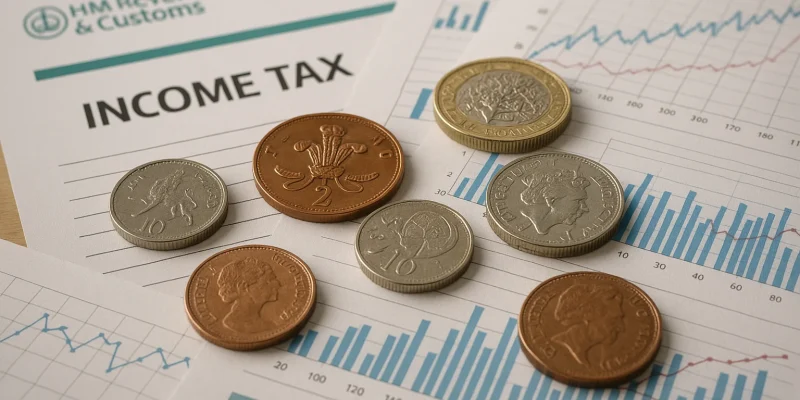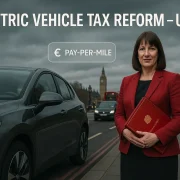
How Much Would 2p On Income Tax Raise?
The UK government faces mounting pressure to stabilise public finances, fund essential services, and address long-term economic challenges.
With borrowing forecasts deteriorating and fiscal rules under strain, a potential 2p rise in the basic rate of income tax has emerged as a serious policy consideration.
As the Chancellor prepares her upcoming budget, this proposed increase raises important questions about revenue generation, economic impact, and fairness.
Understanding how much a 2p rise could raise is key to evaluating its potential effectiveness.
Why Is The UK Government Considering A 2p Rise In Income Tax?

The UK government is facing significant fiscal pressure in the lead-up to Rachel Reeves’ first budget.
With a looming £14 billion gap between current borrowing projections and the fiscal rules set in March, action is necessary to prevent further deterioration in public finances.
This shortfall, highlighted by recent analysis from the Resolution Foundation, could breach the Chancellor’s self-imposed rules unless offset by tax rises or spending cuts. The timing is also crucial.
The Office for Budget Responsibility (OBR) requires early submission of key fiscal decisions so they can incorporate them into economic forecasts. Once submitted, changes to those measures are rare.
A 2p rise in the basic rate of income tax, though politically sensitive, offers an efficient means to:
- Generate a substantial amount of revenue quickly
- Demonstrate fiscal responsibility to the financial markets
- Distribute the cost of economic adjustment in a progressive manner
In addition, such a move would be the first increase in the basic rate of income tax since the 1970s, signalling a significant shift in the government’s willingness to address structural fiscal issues directly.
What Is The Estimated Revenue From A 2p Income Tax Rise?
A 2p increase in the basic rate of income tax is being seriously discussed as a way to strengthen the UK’s financial position.
With borrowing projected to exceed targets, this adjustment could provide a crucial source of additional government revenue without resorting to excessive spending cuts or risky borrowing strategies.
The Financial Calculation Behind The 2p Rise
According to data from HM Revenue & Customs (HMRC), a 1p rise in the basic rate of income tax typically generates around £10 billion annually.
This means a 2p increase would raise approximately £20 billion each year, assuming no significant changes in economic behaviour.
This estimate is based on the taxable income of millions of workers across different income brackets.
Because income tax is progressive, the highest earners would contribute more, helping maintain fairness in the overall system.
Importantly, this measure could cover the £14 billion budget shortfall identified by the Resolution Foundation and provide an additional financial buffer.
The Role Of The Office For Budget Responsibility (OBR)
The OBR’s role is central in validating such fiscal measures. When the Chancellor submits her tax proposals, the OBR conducts independent analysis to determine the likely revenue effects and the broader economic impact.
Their assessment helps ensure that revenue projections are realistic and align with the government’s fiscal framework.
For the 2p increase, the OBR would consider factors such as employment levels, average earnings growth, and inflation.
These projections allow policymakers to gauge how sustainable the measure would be over time and how it might affect household finances.
Comparing The 2p Rise With Other Fiscal Measures
When compared with other tax adjustments, income tax remains one of the most predictable and stable sources of funding.
Alternatives like VAT or corporation tax are more volatile and can have wider inflationary or investment-related consequences. A modest increase in the basic rate provides the government with:
- Consistent and measurable annual revenue
- Minimal administrative complexity
- Predictable fiscal outcomes that help maintain economic stability
Projected Revenue Outcomes
| Tax Increase | Estimated Annual Revenue | Approximate Budget Gap Coverage |
| 1p | £10 billion | Partial |
| 2p | £20 billion | Full + Buffer |
| 3p | £30 billion | Surplus Contribution |
Overall, the 2p rise is viewed as a financially prudent measure, balancing the need for higher revenue with fairness and administrative simplicity.
How Could A Tax Increase Support Economic Growth?

Although tax increases are traditionally seen as restrictive for economic growth, the situation in the UK challenges this assumption.
Strategic tax reform can be used not just to collect revenue but also to promote efficiency and fairness in the tax system.
Raising income tax while simultaneously reducing National Insurance contributions could encourage employment and investment.
It would also reduce distortions between different forms of work, particularly between employment and self-employment.
Other ways a tax increase could support growth:
- Protecting public investment in healthcare, education, and infrastructure
- Reducing uncertainty in fiscal planning, thereby improving investor confidence
- Enhancing social stability by addressing inequalities in tax burdens
Policymakers must balance the short-term impacts on consumption with long-term benefits to productivity and infrastructure quality.
Who Would Be Most Affected By A 2p Income Tax Rise?
The effects of a 2p income tax increase would vary depending on income levels, employment status, and age.
Those who earn above the personal allowance threshold would pay more, while those below it would remain unaffected.
Notably, pensioners would face higher tax bills since they typically do not pay National Insurance.
This group would bear more of the cost if income tax were raised without corresponding National Insurance adjustments.
However, the government could argue that pensioners have benefited significantly from past increases in NHS and public spending, making it fair for them to contribute more during times of fiscal tightening.
Annual Impact On Taxpayers Based On Income Levels
| Annual Income | Tax Before 2p Rise | Tax After 2p Rise | Additional Amount Paid |
| £20,000 | £2,486 | £2,886 | £400 |
| £40,000 | £7,486 | £8,286 | £800 |
| £60,000 | £13,486 | £14,686 | £1,200 |
| £80,000 | £21,486 | £22,886 | £1,400 |
Self-employed individuals and landlords would also be affected, particularly those who benefit from existing tax advantages.
By narrowing the disparity between these groups and traditional employees, the reform could support a more balanced and equitable tax system.
How Does A 2p Tax Increase Compare With Alternative Fiscal Options?
The government has limited tools available to address the fiscal shortfall. Each comes with unique economic and political trade-offs. Among the alternatives to increasing income tax:
- Raising VAT: Increases prices and hits lower-income households hardest
- Increasing corporation tax: Risks discouraging business investment
- Higher capital gains tax: Yields limited revenue and can lead to tax avoidance
Compared with these options, income tax is generally seen as more progressive and stable. It targets those with higher incomes and generates predictable revenue, making it a practical choice for a government committed to responsible budgeting.
Moreover, income tax changes are relatively straightforward to administer and can be implemented quickly, providing the Treasury with immediate fiscal benefits.
What Are The Political And Social Implications Of Raising Income Tax?

Implementing a 2p rise in income tax would have both political and social repercussions.
While economically rational, such a decision challenges traditional political promises and public perceptions about taxation.
For the Labour government, this move must be framed carefully to gain public support and maintain political credibility.
Political Context And Public Perception
Historically, raising income tax has been politically risky. Governments of all parties have avoided altering the basic rate due to fears of backlash from middle-income voters.
However, the current economic environment presents a different reality. With rising public spending demands, especially in the NHS and social care, a modest tax rise may be seen as an act of fiscal responsibility rather than political weakness.
Public sentiment in the UK often supports higher taxation when it is clearly linked to better public services.
Therefore, communication will be critical. The Chancellor must make a strong case that the revenue from the 2p rise will directly fund visible improvements in areas like healthcare, education, and infrastructure.
Implications For Fiscal Credibility And Market Confidence
Raising income tax also signals fiscal discipline to investors and markets. It demonstrates that the government is prepared to make difficult decisions to keep borrowing under control.
This can lead to greater stability in gilt markets and help maintain lower interest rates on public debt.
A consistent and transparent approach to fiscal policy builds credibility with institutions such as the International Monetary Fund (IMF) and credit rating agencies.
By showing a willingness to generate revenue through fair taxation rather than short-term borrowing, the UK strengthens its financial reputation globally.
Social Fairness And Economic Balance
From a social perspective, an income tax increase can promote fairness by ensuring that those with higher earnings contribute proportionally more.
In the context of widening income inequality, such a measure reinforces the principle of shared responsibility for funding public goods.
Key social implications include:
- Strengthening public trust through transparent use of tax revenue
- Supporting redistribution of wealth by targeting higher-income groups
- Preventing deeper cuts to public services that would disproportionately affect low-income households
Balancing Political Risk And Public Good
While the measure may face criticism from opposition parties and segments of the media, its long-term benefits could outweigh short-term political costs.
If implemented alongside reforms such as adjustments to National Insurance or targeted tax relief for low-income earners, the government can position the policy as both fair and economically necessary.
Ultimately, the political and social success of a 2p income tax rise will depend on how effectively it is communicated, how transparently the revenue is allocated, and how visibly it improves public services that matter most to UK citizens.
Could Reducing National Insurance Offset The Income Tax Rise?
One proposed method for reducing the financial burden of a 2p income tax increase is to lower National Insurance contributions for employees.
This would allow the government to maintain workers’ take-home pay while increasing contributions from those who currently do not pay National Insurance, such as pensioners and landlords.
Reducing National Insurance by 1p while increasing income tax by 2p could make the change largely neutral for many working individuals.
This approach would also help align the taxation of earned and unearned income, reducing incentives for tax avoidance.
The benefits of this strategy include:
- Preserving work incentives
- Avoiding additional pressure on household budgets
- Maintaining progressivity in the tax system
This combined approach may also be more politically viable, as it enables the government to demonstrate sensitivity to the cost-of-living concerns of working families while achieving its fiscal objectives.
What Long-Term Benefits Could This Tax Policy Bring To The UK?

In the long term, a well-structured income tax increase could offer multiple benefits for the UK economy and society.
Beyond raising revenue, it can strengthen the social contract between citizens and the state and provide a more stable foundation for investment in public services.
Long-term advantages include:
- Improved funding for healthcare and education
- Greater fiscal resilience against economic shocks
- Enhanced fairness in the tax system by ensuring higher earners contribute proportionally
Moreover, reliable tax revenue supports sustained investment in infrastructure and innovation, two key drivers of productivity.
By addressing distortions in the current tax structure, the government can also create a more efficient and balanced economic environment that supports both growth and equity.
Conclusion
Raising the basic rate of income tax by 2p is not an easy political decision, but it may be the most responsible and effective choice given the UK’s current fiscal landscape.
With borrowing set to exceed targets, public services under strain, and inflation requiring careful management, the government must act decisively.
An income tax rise offers a progressive, stable, and transparent solution. When paired with a potential reduction in National Insurance, it could protect workers while ensuring that those who can afford to contribute more do so.
The measure would help plug the budget gap, support long-term growth, and reflect a fairer distribution of fiscal responsibility.
In facing economic reality, the UK has an opportunity to strengthen its social contract and lay the groundwork for a more equitable and prosperous future.
Frequently Asked Questions
How much revenue does the UK government collect from income tax annually?
The UK government collects over £250 billion annually from income tax, making it the largest source of government revenue.
What role does the Office for Budget Responsibility (OBR) play in tax changes?
The OBR provides independent economic forecasts and evaluates the impact of government policies, including tax changes, on public finances.
Would a 2p income tax rise impact inflation?
Not significantly. Income tax rises are less inflationary than consumption-based taxes like VAT, though the overall effect depends on how the additional revenue is spent.
Are pensioners exempt from income tax rises?
No. Pensioners with taxable income above the personal allowance will see increased tax liabilities, but those below the threshold remain unaffected.
Could National Insurance be reduced to offset the income tax hike?
Yes. A corresponding reduction in National Insurance could balance the financial impact for many workers while still generating revenue from other groups.
What are the alternatives to raising income tax?
Other options include raising VAT, increasing corporation tax, or further borrowing. However, each alternative comes with economic and political trade-offs.
Is a tax rise politically viable for Labour in 2025?
While politically sensitive, a well-justified and clearly communicated income tax rise could gain public support if it funds essential services and promotes fairness.





